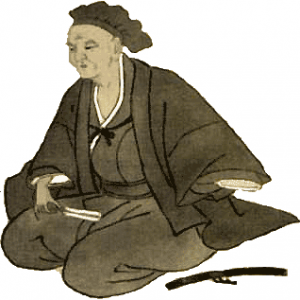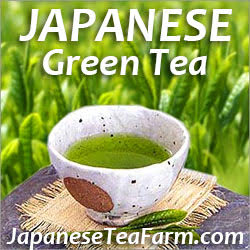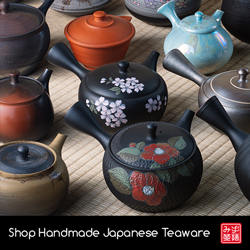
Murata Jukō (村田珠光), born in Nara in 1423, is known as the founder of the Japanese tea ceremony.
He entered priesthood in the Jōdō sect at an early age but he disliked it and decided to go to Kyoto.
While in Kyoto he met Nōami, an art advisor to the Ashikaga shogunate. Nōami taught Jukō about tea.
When he was 30 years old, Jukō became a Zen priest under the Rinzai school.
His Zen master was the famous Ikkyū Sōjun. He taught Jukō that the taste of Zen and the taste of tea are the same.
Ikkyū gave him a hanging scroll with calligraphy from a Zen Chinese master as a certificate of enlightenment.
Jukō incorporated Zen into his new concept of the tea ceremony. He was also influenced with Noh theater and the Renga genre of poetry.
At that time, tea for the upper classes of society was served in expensive Chinese tea ware, and it was mostly a show of power for the parties involved.
Jukō proposed a tea ceremony with more simplicity, which later came to be known as the wabicha style.
He advocated a harmony between the expensive Chinese utensils and the simpler and cheaper Japanese ones.
He started to use the bamboo scoop (chashaku) as opposed to the Chinese ones made with ivory or silver. He also chose the rustic designs of the Japanese Shiragakiyaki and Bizenyaki tea bowls.
In essence, the tea ceremony was starting to become more uniquely Japanese.
Thanks to his friend Nōami, the shogun Ashikaga Yoshimasa became a patron of Jukō.
In a written letter to one of his students, the Kokoro no fumi (心の手文), he explains many of his concepts for the tea ceremony.
For example: “In this way, what’s most detestable is pride and attachment. The expert is subject of envy, and the beginner is looked down on”.
He wanted the tea ceremony to be an activity where people were treated equally.
Another important aspect that he thought of was to use an area of four and a half mats (jo), much smaller than what was used before.
This forced the minimum use of decorative items, and also decreased the number of people that could participate in the ceremony.
By the way, he also placed the hanging scroll that Ikkyū had given him inside his tea room.
Before that it was the custom to use a painting of the Buddha or a work of art. But since then, a piece of calligraphy with a Zen saying has become the standard.
His successor Takeno Jōō would continue refining his wabicha style of the tea ceremony.
Takeno Jōō would later on pass this knowledge to his pupil Sen no Rikyū, who completed and perfected the Japanese tea ceremony.






August 10, 2017
Nice post! This helps to fill gaps in my knowledge about the origins of the tea ceremony in Japan.
August 10, 2017
Thank you Damien, I’m happy that you liked this post.
August 17, 2017
Great post and good addition to the tea knowledge. Really liked it because I am interested in the period of Shogun Ashikaga Yoshimasa period due to its influence on tea and Japanese culture. I am sure you have read Donald Keene’s “Yoshimasa And The Silver Pavillion”. If not, please read it.
August 17, 2017
Hi Lochan
Thank you for the recommendation, I will add that book to my wish list.